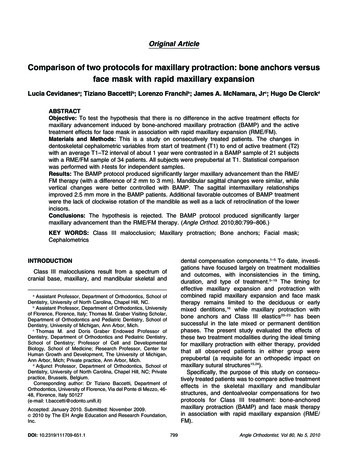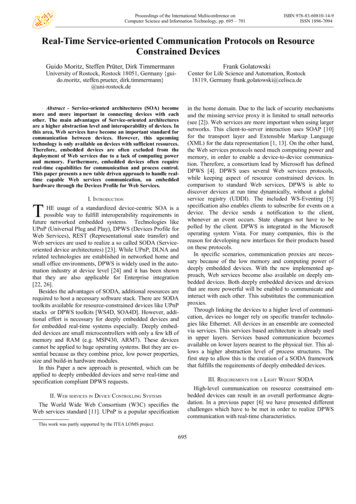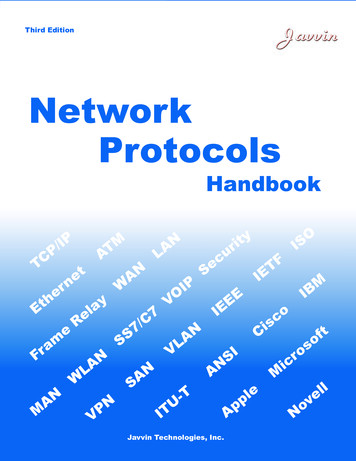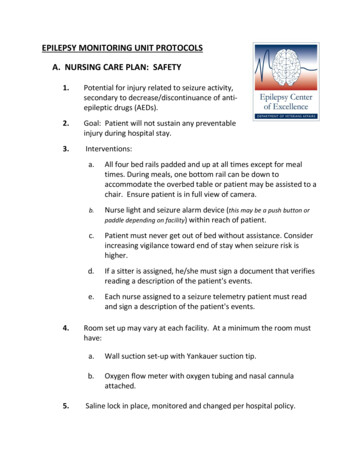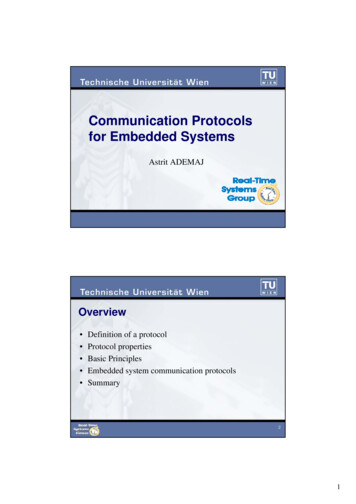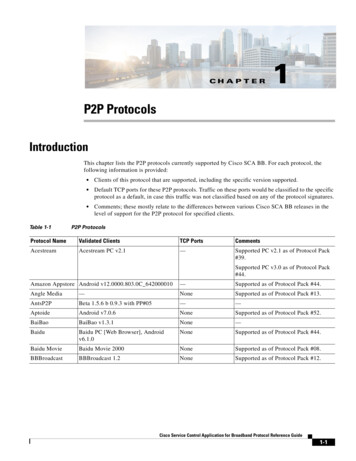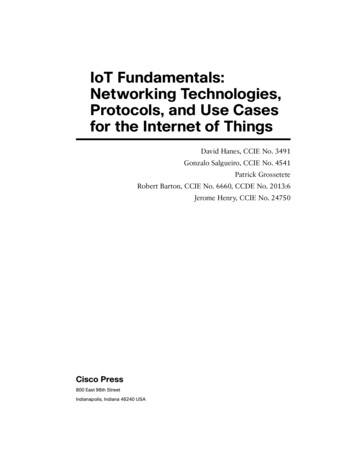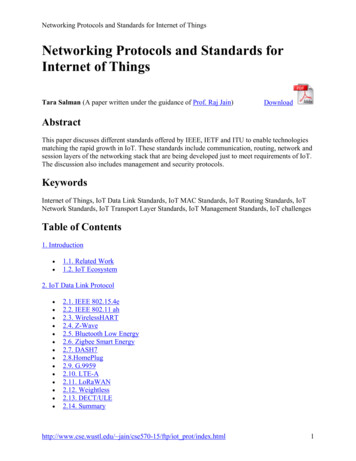
Transcription
Best Practices in MR Imaging: State-of-the-Art Protocols6th EditionMR Protocols for GE Healthcare ScannersImages courtesy of David S. Enterline, MD, FACR,and Jeffrey H. Maki, MD, PhD.INTRODUCTIONThese magnetic resonance (MR) protocols were developed by an expert consensus panel for use onGeneral Electric (GE) MR imaging machines, and were developed for high-end platform scanners withmultichannel phased array coils and parallel reconstructions. The protocols are divided into 3 sections: Body MR imaging MR angiography Central nervous system (CNS) MR imagingThe protocol parameters can generally be adapted to work with other software platforms or releases and hardwareconfigurations but may require small modifications that can be made by a knowledgeable and experienced MRtechnologist. Scan times may increase in some circumstances.In these protocols, attention has been given not only to specific machine parameters at 1.5T and 3T but alsoto how to prepare the patient, streamline the exam, and make the best use of contrast material, whether it is astandard gadolinium-based extracellular fluid agent or a high-relaxivity gadolinium-based contrast agent(GBCA), such as MultiHance (gadobenate dimeglumine).Each protocol contains a brief description of patient preparation, special notes on coil choice and placement,suggestions for contrast dose and administration rate, and suggestions concerning timing of fluoroscopictriggering, if appropriate.The consensus panel consisted of the following experts in radiology:Mark C. DeLano, MD, FACR ̶ Advanced Radiology Services, PC, Grand Rapids, MichiganVera L. Kimbrell, BSRT, (R)(MR) ̶ Duke University, Durham, North CarolinaScott B. Reeder, MD, PhD ̶ University of Wisconsin School of Medicine and Public Health, Madison, WisconsinHoward A. Rowley, MD ̶ University of Wisconsin School of Medicine and Public Health, Madison, WisconsinSteffen Sammet, MD, PhD, DABR, DABMRS, FAMP ̶ The University of Chicago Medical Center, Chicago, IllinoisMegan E. Vadnais, BSRT, (R)(MR) ̶ University of Wisconsin School of Medicine and Public Health, Madison, WisconsinDisclaimerThe content and views presented in this educational activity are those of the authors and do not necessarilyreflect those of Medical Education Resources, ABC Medical Education, and/or Bracco Diagnostics Inc. Theauthors have disclosed if there is any discussion of published and/or investigational uses of agents that are notindicated by the US Food and Drug Administration (FDA) in their presentations. The protocols presented herewere developed for adult patients of average weight.Before prescribing any medicine, primary references and the full prescribing information for each productshould be consulted. Any procedures, medications, or other courses of diagnosis or treatment discussed orsuggested in this activity should not be used by clinicians without evaluation of their patient’s conditions andpossible contraindications on dangers in use, review of any applicable manufacturer’s product information, andcomparison with recommendations of other authorities. The information presented in this activity is not meant toserve as a guideline for patient management.Off-Label StatementThis educational activity contains discussion of published and/or investigational uses of agents that are not onlabel by the FDA. The opinions expressed in the educational activity are those of the faculty. Please refer to theofficial prescribing information for each product for discussion of approved indications, contraindications, andwarnings. Further, participants should critically appraise the information presented and are encouraged to consultappropriate resources for any product or device mentioned in this activity.1
Best Practices in MR Imaging: State-of-the-Art Protocols6th EditionMR Protocols for GE Healthcare ScannersMR Protocols for Body MR ImagingContrast timing is extremely important for abdominal MR imaging, particularly for high-quality liver imaging. Werecommend the use of fluoro-triggering or “SmartPrep” methods rather than the use of a timing bolus.All body MR imaging protocols presented here were developed by Scott B. Reeder, MD, PhD, Steffen Sammet,MD, PhD, DABR, DABMRS, FAMP, and Megan E. Vadnais, BSRT, (R)(MR) for 1.5T and 3T systems. Specificprotocols include: Abdomen‒ Generic Abdomen Pelvis 1.5T and 3T‒ Appendicitis Noncontrast 1.5T and 3T‒ MR Enterography 1.5T and 3T Liver‒ Liver/Pancreas Extracellular Agent 1.5T and 3T‒ Liver/Pancreas Hepatobiliary Agent 1.5T and 3T‒ Magnetic Resonance Cholangiopancreatography (MRCP) Noncontrast 1.5T and 3T‒ Diffuse Liver Disease 1.5T and 3T Pelvis‒ Generic Pelvis 1.5T and 3T‒ Female Pelvis Malignant 1.5T and 3T‒ Female Pelvis Benign 1.5T and 3T‒ Uterine Anomaly 1.5T and 3T‒ Rectal Cancer 1.5T and 3T‒ Perianal Fistula 1.5T and 3T‒ Prostate 1.5T and 3T Adrenal and Renal‒ Adrenal 1.5T and 3T‒ Renal 1.5T and 3TGeneral Notes Intravenous access should be obtained with an 18- to 22-gauge needle We suggest the use of a contrast injector and a saline flush of a minimum of 20 to 30 mL at the sameinjection rate as the contrast injection (1.5-2.0 mL/sec) Breath holding is critical to good image quality for thoracic or abdominal MR imaging. Precontrastscans should be used to ensure that the patient can both breath hold adequately and understand theinstructions. We recommend breath holding at end-expiration (end tidal volume) When parallel imaging is used, care must be taken to increase the field of view sufficiently to avoidresidual aliasing artifact. This is generally more often a problem for coronal imaging, which may requireplacing the arms over the head or elevating the arms by the patient’s side In patients with renal failure, consider using a half-dose (0.05 mmol/kg) of a high-relaxivity Group IIcontrast agent such as MultiHance (gadobenate dimeglumine), particularly at 3T2
Best Practices in MR Imaging: State-of-the-Art Protocols6th EditionMR Protocols for GE Healthcare ScannersMR Protocols for Body MR AngiographyAll protocols should use Fluoro-Triggered (FT) magnetic resonance (MR) angiography fluoroscopic imagingfor bolus detection. MR imaging protocols for MR angiography presented here include 1.5T and 3T systemsand were developed by Scott B. Reeder, MD, PhD, Steffen Sammet, MD, PhD, DABR, DABMRS, FAMP, andMegan E. Vadnais, BSRT, (R)(MR) for the following procedures: Abdominal– MRA Contrast-enhanced Abdomen 1.5T and 3T– MRA Noncontrast-enhanced Abdomen 1.5T and 3T– Thoracoabdominal Aortic Aneurysm MRA 1.5T and 3T Cardiovascular– Cardiac Valve Disease 1.5T and 3T– Cardiac Basic Anatomy and Function 1.5T and 3T– Pulmonary Vein Mapping 1.5T and 3T– Thoracic MRA 1.5T and 3T Peripheral– Lower Extremity Contrast-enhanced MR Venography (CE MRV) 1.5T and 3T– Runoff Abdomen to Lower Extremity MRA 1.5T and 3T– MRA Noncontrast-enhanced Runoff 1.5T and 3T– Time-Resolved MRA 1.5T and 3TThe rationale for the patient preparation for contrast-enhanced MR angiography is based on a hypothetical genericpatient. Individual protocols may include important variations and will be delineated in the specific protocol.General Notes Intravenous access should be obtained with an 18- to 22-gauge needle, inserted preferably in the antecubitalfossa. Right side is preferred (when possible) for thoracic or carotid MR angiography Use respiratory bellows – gating parameters:– R-R intervals 2-3– Trigger point 40%– Trigger window 30%– Delay minimum The basic sequences recommended are intended to achieve both anatomic localization and high-qualityanatomic imaging to complement the angiographic sequences that are performed. These include:– 3-plane localizer– Coronal single-shot fast spin-echo (FSE)– Axial T2 FSE (respiratory triggered)– 3D (three-dimensional) contrast-enhanced MR angiography FT (precontrast-practice breath hold)– 3D contrast-enhanced MR angiography FT (postcontrast)– 3D contrast-enhanced MR angiography FT (2nd postcontrast)– Axial fast spoiled gradient-echo postcontrast fat-saturated3
Best Practices in MR Imaging: State-of-the-Art Protocols6th EditionMR Protocols for GE Healthcare Scanners A power injector is highly recommended with a minimum of 20- to 30-mL saline flush delivered at the sameinjection rate as the contrast injection Breath holding is critical to good image quality for thoracic or abdominal MR angiography. Precontrast orpractice scans help ensure that the patient can both breath hold adequately and understand theinstructions When parallel imaging is used, care must be taken to not have wraparound artifact on the vascularstructures. This generally requires prescribing a large field of view beyond the body wall, and forabdominal imaging, it requires placing the arms over the head or elevating the arms at the patient’sside. When performing the calibration scan, overprescribe by one-fourth the area of interest in thesuperior and inferior directions to reduce scan cutoff. Calibration scans are performed in the Axial planeMR Protocols for Central Nervous System (CNS) MR ImagingNewer hardware and software platforms at both 1.5T and 3T allow efficient protocol options for a wide rangeof CNS indications. This section suggests multiple consensus methods for optimizing examination of patientsundergoing MR imaging in the CNS. Core sequences in each protocol are identified, and their aggregate useconstitutes a complete examination for each protocol. Alternative sequences of interest are included for emergingtechnologies, specific target anatomy, or subspecialty preference.1.5T and 3T CNS MR imaging protocols presented here were developed by Mark C. DeLano, MD, FACR, HowardA. Rowley, MD, and Vera L. Kimbrell, BSRT, (R)(MR) for the following procedures: Brain– Routine Adult Brain 1.5T and 3T– Brain Neck Magnetic Resonance Angiography (MRA)/Magnetic Resonance Venography (MRV)1.5T and 3T– Motion Brain 1.5T and 3T– Routine Stroke Fast 1.5T and 3T– Hyperacute Stroke Brain 1.5T and 3T– Tumor Brain 1.5T and 3T– Multiple Sclerosis Brain 1.5T and 3T– Pediatric Brain– Epilepsy Brain 1.5T and 3T Specialty Brain– Hydrocephalus Brain 1.5T and 3T– Cerebrospinal Fluid Flow 1.5T and 3T– Pituitary 1.5T and 3T– Cranial Nerves/Internal Auditory Canals 1.5T and 3T– Vessel Wall 1.5T and 3T Head and Neck– Orbits 1.5T and 3T– Soft Tissue Neck 1.5T and 3T– Sinuses/Face 1.5T and 3T4
Best Practices in MR Imaging: State-of-the-Art Protocols6th EditionMR Protocols for GE Healthcare Scanners Spine– Cervical Spine 1.5T and 3T– Thoracic Spine 1.5T and 3T– Lumbar Spine 1.5T and 3T– Total Spine 1.5T and 3T– Specialty Spine 1.5T and 3T– Brachial Plexus 1.5T and 3TGeneral CNS Protocol Notes Standard brain. There are multiple approaches to obtain various tissue parameter weightings at both1.5T and 3T, such that “standard” imaging refers more to the general purpose nature of the protocolrather than the core sequence choices. The core preferences of our consensus panel are indicatedwithin each protocol T1. Four widely used techniques for obtaining T1-weighting are included: spin echo (SE), fast spinecho (FSE), T1 fluid-attenuated inversion recovery (T1-FLAIR), and 3D IR-prepared FSPGR (BRAVO)– SE is the T1 reference standard for image contrast at 1.5T, although the other sequences haveunique advantages and are included as options. Due to T1 prolongation at 3T and associated loss ofgray-white contrast there is no consensus standard for T1-weighting– FSE with its intrinsic magnetization transfer effects results in decreased gray-white contrast but maydepict contrast enhancement to better advantage– T1-FLAIR and BRAVO are inversion prepared, facilitating excellent gray-white differentiation butwith the potential disadvantage of inconspicuous contrast enhancement due to the markedprecontrast hypointensity of many lesions and subsequent isointensity to surrounding brain postcontrast– BRAVO, as a standard 3D sequence, has the key advantage of multiplanar reconstruction capabilityof the isotropic data sets, and dynamic gray-white contrast that is desirable for most applications– Magnetization transfer (MT) is an optional feature that can be added to increase contrastenhancement effects on SE imaging, and is typically added to one plane of imaging T2. Most sites use FSE sequences rather than SE. PROPELLER is effective for dealing with patientmotion, and is the primary FSE sequence used at many sites. Some users add fat saturation to T2imaging as an option T2-FLAIR. Improves lesion detection particularly at the brain-CSF interface. Postcontrast T2-FLAIRimaging effectively uses a time delay postinjection for patients who will be receiving contrast. Thisimproves lesion detection on subsequent T1 imaging postcontrast. The T2-FLAIR images also haveintrinsic T1 contrast that allows visualization of both edema and enhancement on one sequence formany lesions. Both 2D and 3D T2-FLAIR sequences are commonly performed, with the advantage ofmultiplanar reconstruction capability and fewer CSF pulsation artifacts of the 3D CUBE T1 CUBE. This FSE-based volumetric sequence can be performed either before or after contrast.Beyond the usual 3D attributes (such as high resolution and multiplanar reconstructions), it hasparticular advantages postcontrast, where it provides black blood imaging, supports fat saturation, andshows outstanding tissue contrast for enhancing lesions. T1 CUBE is suitable for routine brain imagingand also orbital and cranial nerve exams. Many sites now use T1 CUBE as a supplement to postcontrastT1 BRAVO and other sequences5
Best Practices in MR Imaging: State-of-the-Art Protocols6th EditionMR Protocols for GE Healthcare Scanners Susceptibility. Due to the reduced susceptibility weighting of FSE methods, a T2*-GRE sequence canbe added as an option to detect blood products and calcium. The SWAN sequence has been shown todramatically demonstrate subtle areas of blood and calcium and has become a common protocolchoice Diffusion. Most br
Best Practices in MR Imaging: State-of-the-Art Protocols 6th Edition MR Protocols for GE Healthcare Scanners MR Protocols for Body MR Imaging Contrast timing is extremely important for abdominal MR imaging, particularly for high-quality liver imaging.
